When your fruit trees start bearing plump and attractively colored fruits, birds are often drawn to them. To protect the fruits you’ve worked hard to cultivate from being pecked by birds, it’s crucial to choose the right bird netting.
This article will discuss things to consider when selecting bird netting for fruit trees and recommend some of the more durable products with different materials on the market, with an emphasis on affordability. We’ll also touch on some tips for using bird netting effectively.
How to Choose Bird Netting for Your Fruit Trees?
When selecting bird netting for fruit trees, various factors need consideration. These include the material of the netting, the size of the mesh holes, the maximum dimensions and shape of the net, availability of support accessories, cost per square unit, and warranty, among others. Let’s delve into each of these aspects.
1. Material Selection
The choice of material for fruit tree bird netting is crucial, as it directly affects the net’s durability, efficacy, and environmental impact. Here are some recommended materials for bird netting:
| Material | Advantages | Disadvantages | Applicable Scenarios |
| Polypropylene | 1. UV resistant 2. Lightweight, easy to install and move 3. Recyclable, environmentally friendly 4. Economical |
1. Slightly lower relative strength | 1. Economically limited situations, short-term use 2. Needs to be lightweight and easy to install |
| Nylon | 1. High strength 2. Good elasticity fits the shape of fruit trees 3. Longer lifespan |
1. Relatively higher price 2. If untreated, may be sensitive to UV rays |
1. High-quality nets expected for multi-year use 2. Nets that require good elasticity and strength |
| Polyethylene | 1. Water-resistant, does not absorb moisture 2. UV resistant 3. Sturdy and durable |
1. Relatively poor elasticity | 1. Long-term exposure to rainy environments
2. Needs to be long-lasting but does not require much elasticity |
2. Mesh Hole Size
Choosing the appropriate mesh size is crucial for protecting your fruit trees from birds. If the holes are too large, small birds can easily fly through; if too small, they might impede ventilation and sunlight for the trees, possibly even squeezing or damaging the fruits. Thus, choosing the right hole size not only effectively safeguards the fruits but also ensures the healthy growth of the trees.
Generally speaking, a mesh size of 1/2 inch (about 1.27 cm) to 3/4 inch (about 1.9 cm) is considered ideal. Such a size can block the majority of birds, especially common orchard pests like sparrows, cherry birds, and other small fliers. At the same time, it ensures appropriate light and air circulation, promoting healthy tree growth.
3. Color
Color can influence the effectiveness of bird deterrence when selecting fruit tree bird netting. Black is often recommended by many agricultural experts mainly because it’s less noticeable to birds in nature, thus enhancing the repelling effect. Moreover, black offers a degree of resistance to ultraviolet rays, increasing its lifespan under sunlight.
Some individuals might opt for green netting as it can blend seamlessly with surrounding greenery, offering a more natural visual effect. White is another choice, but its bird-repelling efficacy may not be as potent as black, since birds might detect it more easily under certain lighting conditions.
3. Size and Shape
When choosing bird netting, you need to measure the height and spread of your fruit trees first, ensuring the netting can cover the tree canopy comprehensively, preventing any bird damage. For smaller sets of trees, pre-made bird nets can be a good choice. These nets typically come in fixed dimensions and shapes, often accompanied by installation accessories, making the set-up process easier.
For larger trees or extensive orchards, buying bird netting in bulk from suppliers is more suitable. This allows farmers to cut according to their needs, catering to different tree sizes. For installation, professional teams and equipment might be required.
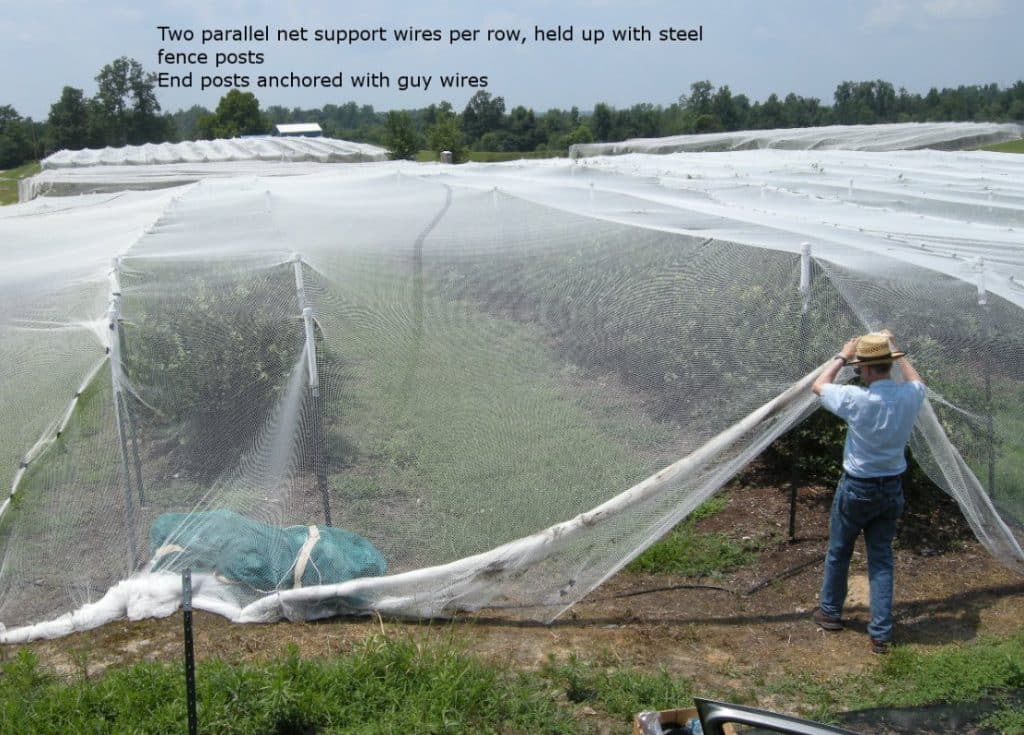
Install bird netting – uky.edu
One thing to note is that due to the square or diamond shape of the mesh and the elasticity of the material, the net’s length and width might vary based on stretching. So, if not stretched, its size might be considerably smaller than advertised.
4. Price
The price of bird netting varies based on material, size, service, and whether installation accessories are provided. Generally, current retail market prices for bird netting range between $0.01 to $0.06 per square foot (with larger sizes typically being more economical).
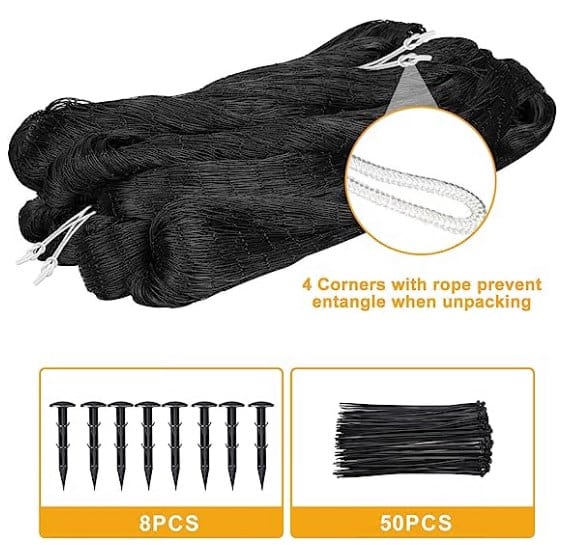
Black bird netting with install
If you’re choosing netting for a vast orchard, consider sourcing from global suppliers or factories for better discounts. For example, our factory INSONSHADE offers free samples of fruit tree netting and bulk custom orders to customers, with prices significantly lower than retail sellers on Amazon.
5 Recommended Bird Netting Products for Retail Customers
If you’re looking to purchase bird netting ranging in size from 25 feet to 100 feet, we have selected a few retail products of different materials based on customer reviews. We hope you find them suitable!
1. BSTPCOO Garden Bird Netting
This is a BSTPCOO black Bird Netting made of UV-resistant, lightweight, and durable Nylon material. Additionally, BSTPCOO includes zip ties and wooden stakes to ensure easy installation on your fruit trees.
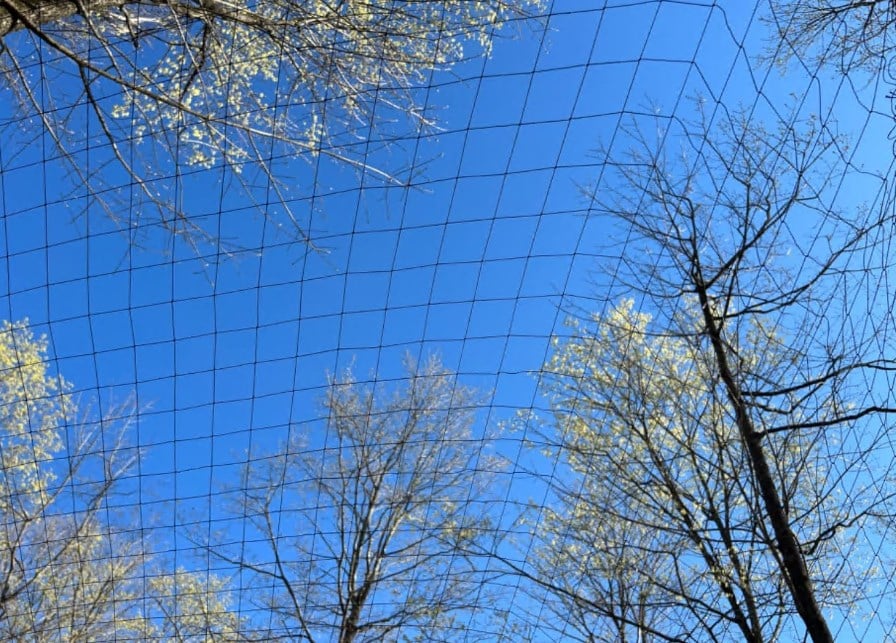
BSTPCOO bird netting
There are 8 different size options available, ranging from 25 x 15 feet to 50 x 100 feet. Mesh sizes of 1 inch and 2.4 inches are available, with a cost of around $0.02 per square foot. Larger sizes offer a more cost-effective rate per square foot.
2. JUNKOGO Bird Netting
JUNKOGO’s bird netting uses advanced warp knitting technology, enhancing the net’s strength and durability. While priced at around $0.04 per square foot, which is a bit pricier compared to other materials, it holds high customer ratings.
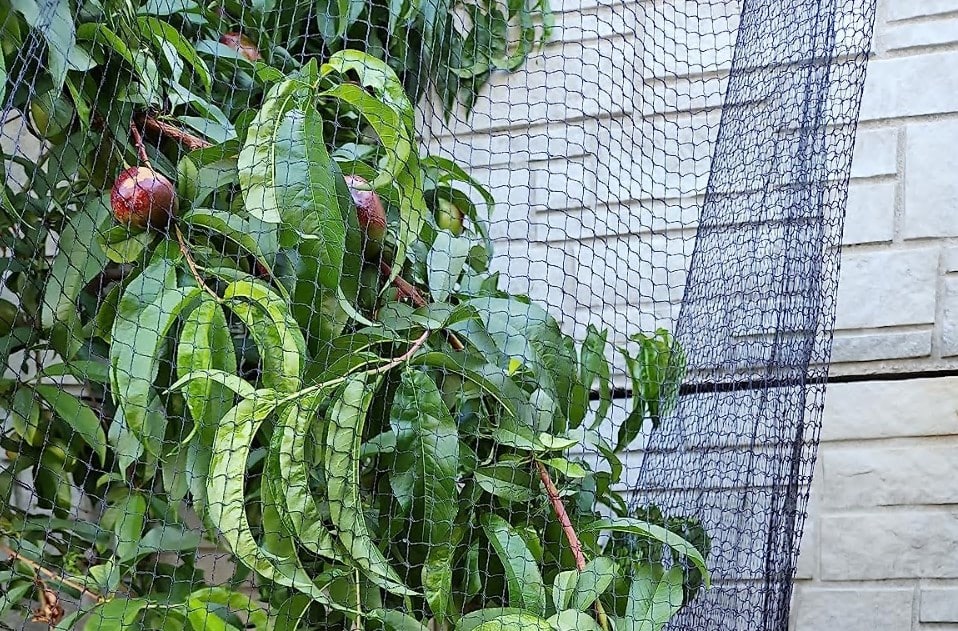
JUNKOGO bird netting
Various sizes are available, ranging from 7.5 x 65 feet, 7.5 x 100 feet to 50 x 50 feet. Mesh sizes of 0.5 inches and 1 inch are the standard for bird netting, effectively blocking birds, deer, squirrels, rabbits, and other animals.
3. Harvesto Heavy Duty Bird Netting
If you have larger trees to protect, then Harvesto’s bird netting is a great choice. One of the five size options they offer is a massive 100ft x 100ft net, which covers a vast area. With a ½ inch mesh size, it’s perfect for protecting vegetable gardens, blueberry fields, fruit trees, and more from small birds, rabbits, deer, and other animals.
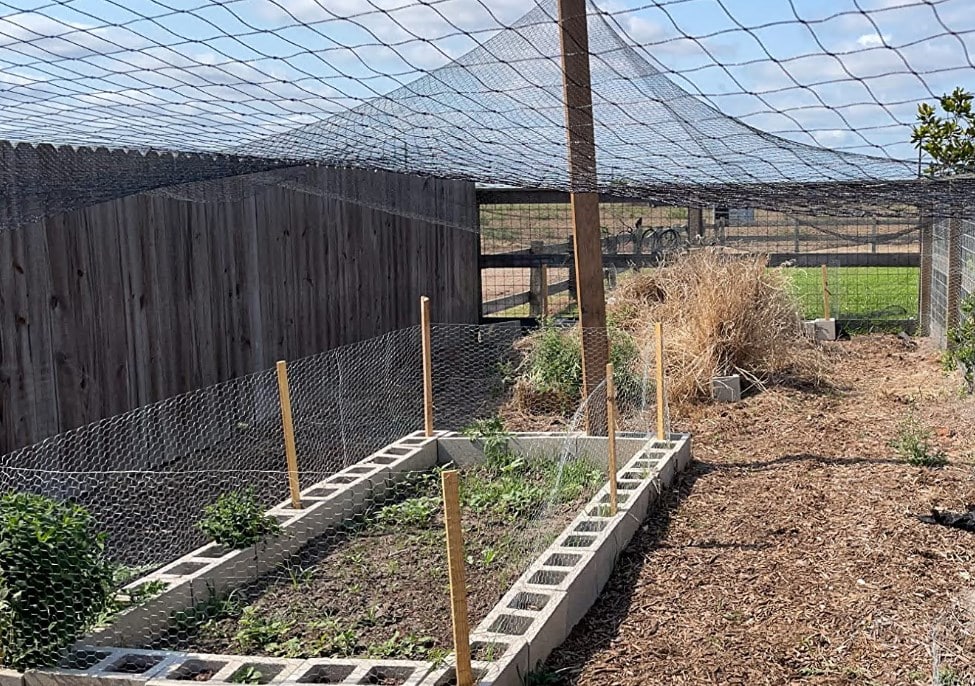
Harvesto HDPE bird netting
Made from HDPE (High-Density Polyethylene) with added UV stabilizers and water resistance, this netting is designed for prolonged outdoor use. For sizes over 50 ft, the cost is around $0.035 per square foot, making it a premium choice compared to standard Nylon, Polypropylene, and Polyethylene nets.
4. AlpineReach Garden Netting for Fruit Trees
The AlpineReach Bird Netting is quite popular, boasting thousands of positive reviews on Amazon. Available sizes are 7.5ft x 65ft, 15ft x 30ft, and 15ft x 50ft, with both black and green color options.
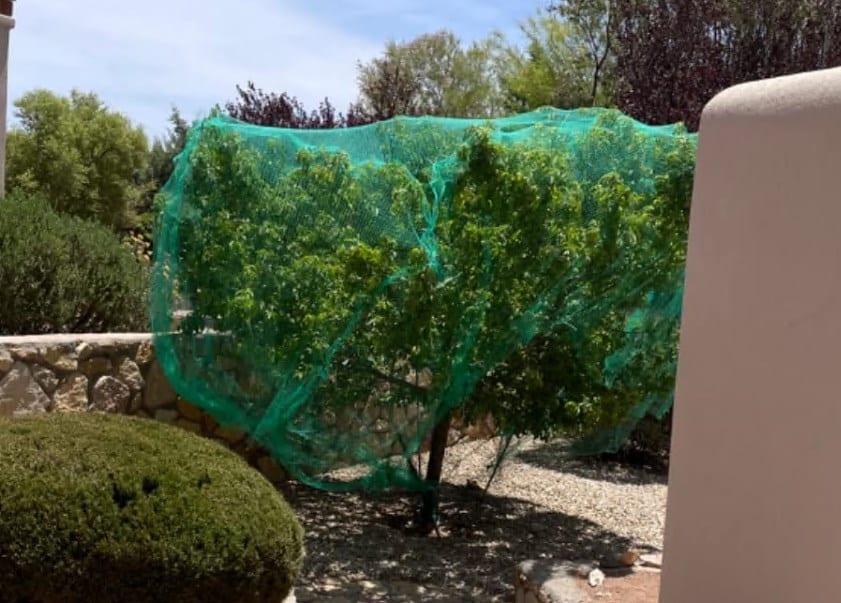
AlpineReach garden netting for fruit tree
With a mesh size of ⅝ inch, the material is durable and has excellent elasticity, making it ideal for protecting medium to small-sized fruit trees from birds, deer, and other animals. However, at $0.06 per square foot, it’s slightly more expensive than some of the other options listed above.
5. Rolan Bird Netting
The Rolan Store offers three different sizes of green Bird Netting: 13 x 20, 13 x 40, and 13 x 65 feet. With a mesh size of 0.8 x 0.8 inches, it effectively protects your fruit trees from bird damage. Made of lightweight polypropylene, this material is UV-resistant and anti-corrosive. Prices range from $0.02 to $0.039 per square foot, with larger sizes being more cost-effective.
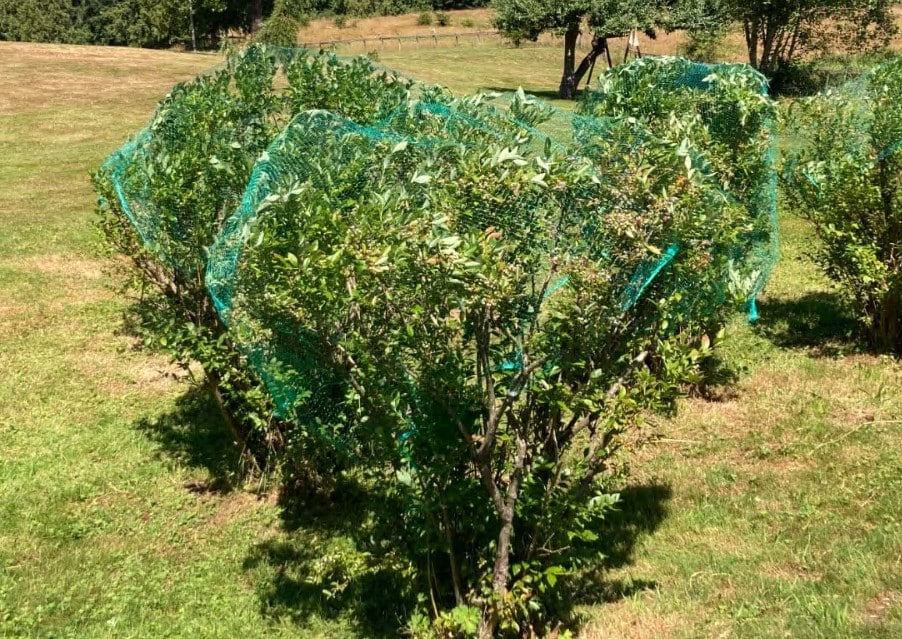
Rolan bird netting
Bird Netting Related FAQs:
FAQ 1. When to put bird netting on trees?
Firstly, the optimal time to install bird netting is when the fruit begins to mature but is not yet fully ripe. Birds typically start seeking fruits as a food source during this period.
For trees like cherries, blueberries, and grapes, the netting should be placed a few weeks before the fruit is about to ripen. Moreover, if you observe that birds have begun showing interest in the trees, even if the fruit has not started maturing, it might be wise to consider deploying the netting early.
Secondly, apart from considering the maturity of the fruits, one should also be mindful of the birds’ activity and breeding season. During their breeding season, birds have an increased food requirement and might actively seek food sources.
In this period, trees are likely to experience more frequent visits from birds. Therefore, setting up bird netting is crucial during the birds’ breeding season.
FAQ 2. Will bird netting keep squirrels out?
Bird netting might not be fully effective against particularly stubborn and active squirrels, as they could potentially bite through or tear these nets. For effective squirrel prevention, it’s advisable to opt for more robust and durable nets specifically designed against squirrels.
If your fruit trees are located in areas frequented by squirrels, ensure that the netting fully covers the tree or plant and is secured to the ground, minimizing the chances of squirrels entering from below. Regularly inspect the netting for damages or tears made by squirrels and repair them promptly.
FAQ 3. Can shade cloth be used as bird netting?
Agricultural shade cloth is designed to provide plants with shade and protect them from direct sunlight. Its mesh design is smaller to ensure shading effects. However, for fruit trees, ample sunlight is essential for their healthy growth, making the use of shade cloth not the best choice.
Furthermore, birds usually fly into fruit trees from the sides and bottom. If one were to entirely wrap a fruit tree with shade cloth, the small mesh would hinder air circulation, which is detrimental to temperature regulation and the healthy growth of the tree. So, although shade cloth can prevent birds, its prolonged use might negatively impact the growth and health of the fruit trees.
